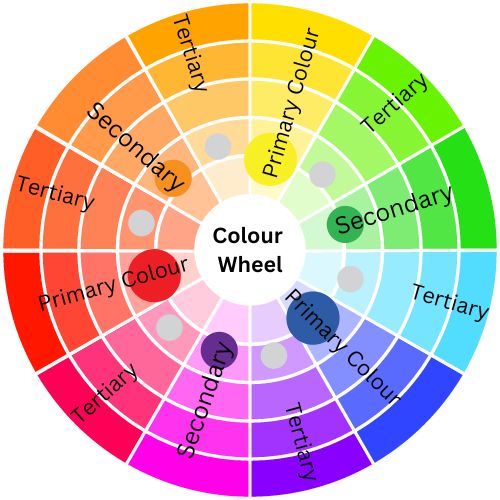- Home
- the colour wheel
- what are the primary colours
What Are The Primary Colours
Welcome to the enchanting world of art, so what are the primary colours?
One of the fundamental aspects of art - especially for those beginning their artistic journey - is understanding the "Primary Colours in Art" so let's have a chat about them.
But what exactly are primary colours?
Primary colours in art are:
- Red
- Blue
- Yellow
These three powerful and vibrant colours are the building blocks of all other colours, simply put, they cannot be created by mixing any other colours together, they are unique.
When you mix these three primary colours, you can create Secondary colours, for example, mixing:
- Red and Blue will create purple
- Yellow and Blue will create green
- Red and Yellow will create orange
Certainly, these three colours are indeed the starting foundation of all art projects.
The Colour Wheel
 The Colour Wheel
The Colour WheelOnce you know about primary colours, you might wonder how to practice working with them. A useful tool for this is a "colour wheel". This wheel puts primary and secondary colours into a circle so you can see the relationships between them.
The colour wheel is a versatile tool in creating art, it not only teaches you how to mix colours, but also shows you how different colours can relate to and complement each other.
It is therefore integral to understand the colour wheel as it guides artists in creating balanced and harmonious artwork.
What Are The Primary Colours
Now, let's focus on each of the primary colours in art and their impact individually.
Red - it's a colour that usually signifies strong emotions such as love and anger. It is bold and attractive and can bring attention to certain areas in your artwork.
Blue - this colour often represents reasons, calm, and tranquility, and it can add depth and peace to your artwork. It is the colour of the sky and sea and is often used to create a soothing and relaxing atmosphere in art.
Yellow - This vibrant colour is associated with joy, happiness, and energy. Its brightness can bring a sense of light and optimism into your artwork. Use it wisely to create wonderful emotions in your pieces.
For beginners in art, using primary colours in your first few works can be a great exercise. It allows you to focus on understanding the properties of colour and how they interact with each other.
Not only this, exploring primary colours provides insights into colour balancing – how different colours create emotional responses, and how they can guide the viewer's eye around a piece of artwork.
Furthermore, the primary colours carry symbolic meanings, they can influence the viewer's perception. By using the right colours and combinations, an artist is able to evoke specific emotions and reactions from their audience.
Now, we've demystified what primary colours are and their role in art, let's underscore a key aspect. To truly master the use of primary colours, practice is essential, just as with any skill in art.
Take the time to experiment with your primary colours and the various shades they can create. Play around with your colour pencils and colour wheel, witness the transformations and revelations that occur when you begin to mix.
In the realm of art, just knowing about primary colours isn't enough. A practical understanding and the ability to manipulate these colours to achieve your desired effect is important.
Remember, art is a form of expression. The primary colours are there as a guide, yet it’s the explosion of your exploration, creativity and innovation that makes your art truly yours.
To conclude, primary colours in art are more than just red, blue, and yellow, they are the genesis of creation, bringing depth, emotion, and life to your artwork.
So delve in, play around with these foundational colours, and unleash your hidden artist, creating your ensemble of radiant and resonant beauty.



